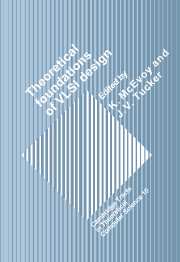1 - Theoretical foundations of hardware design
Published online by Cambridge University Press: 06 November 2009
Summary
INTRODUCTION
The specification, design, construction, evaluation and maintenance of computing systems involve significant theoretical problems that are common to hardware and software. Some of these problems are long standing, although they change in their form, difficulty and importance as technologies for the manufacture of digital systems change. For example, theoretical areas addressed in this volume about hardware include
models of computation and semantics,
computational complexity,
methodology of design,
specification methods,
design and synthesis, and
verification methods and tools;
and the material presented is intimately related to material about software. It is interesting to attempt a comparison of theoretical problems of interest in these areas in the decades 1960–69 and 1980–89. Plus ça change, plus c'est la même chose?
Of course, the latest technologies permit the manufacture of larger digital systems at smaller cost. To enlarge the scope of digital computation in the world's work it is necessary to enlarge the scope of the design process. This involves the development of the areas listed above, and the related development of tools for CAD and CIM.
Most importantly, it involves the unification of the study of hardware and software. For example, a fundamental problem in hardware design is to make hardware that is independent of specific fabricating technologies. This complements a fundamental problem in software design – to make software that is independent of specific hardware (i.e., machines and peripherals).
- Type
- Chapter
- Information
- Theoretical Foundations of VLSI Design , pp. 1 - 62Publisher: Cambridge University PressPrint publication year: 1990
- 4
- Cited by



